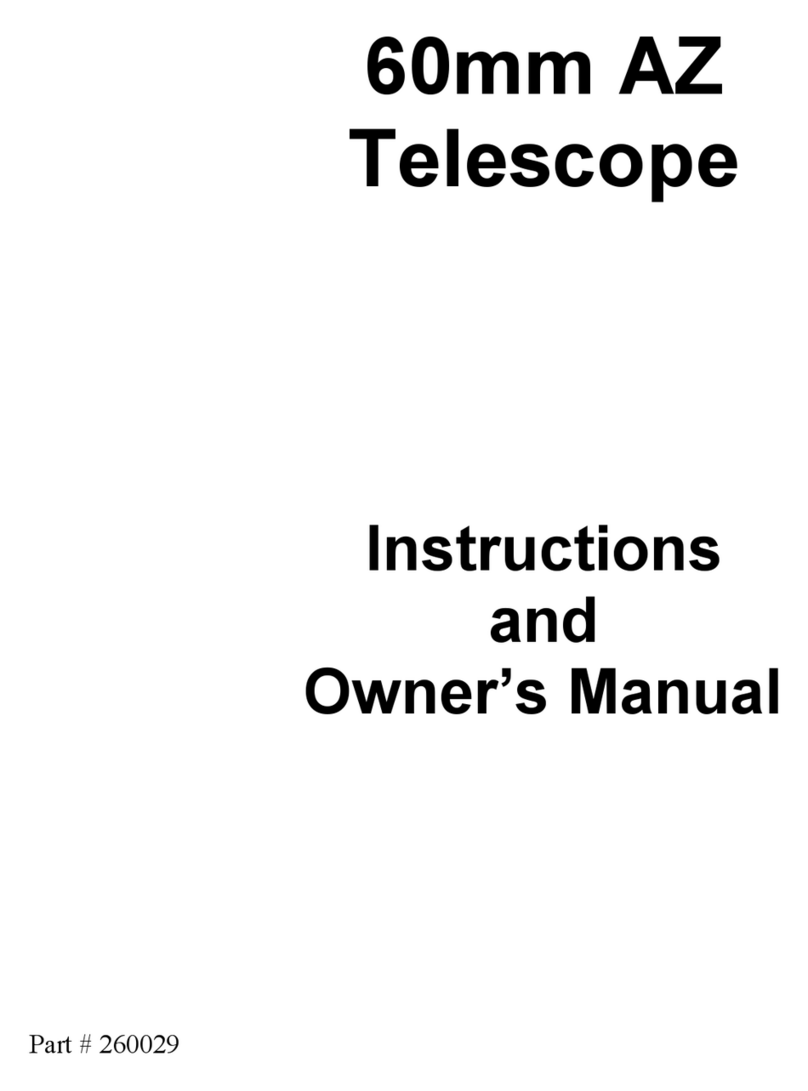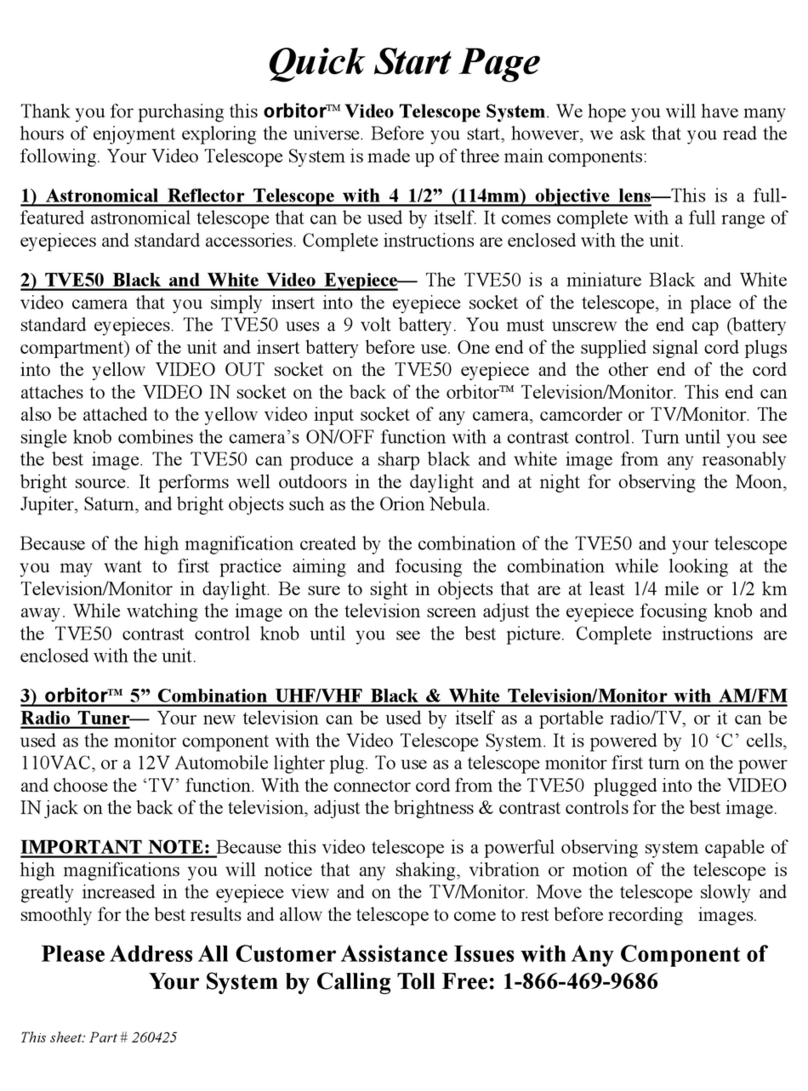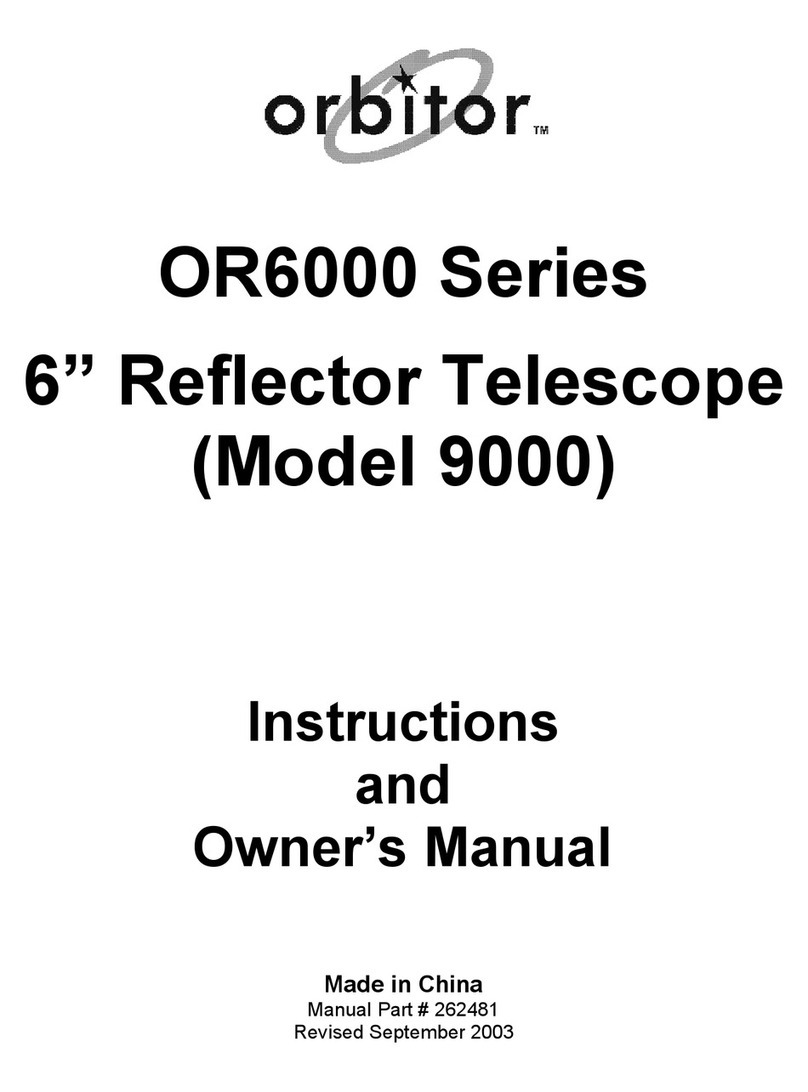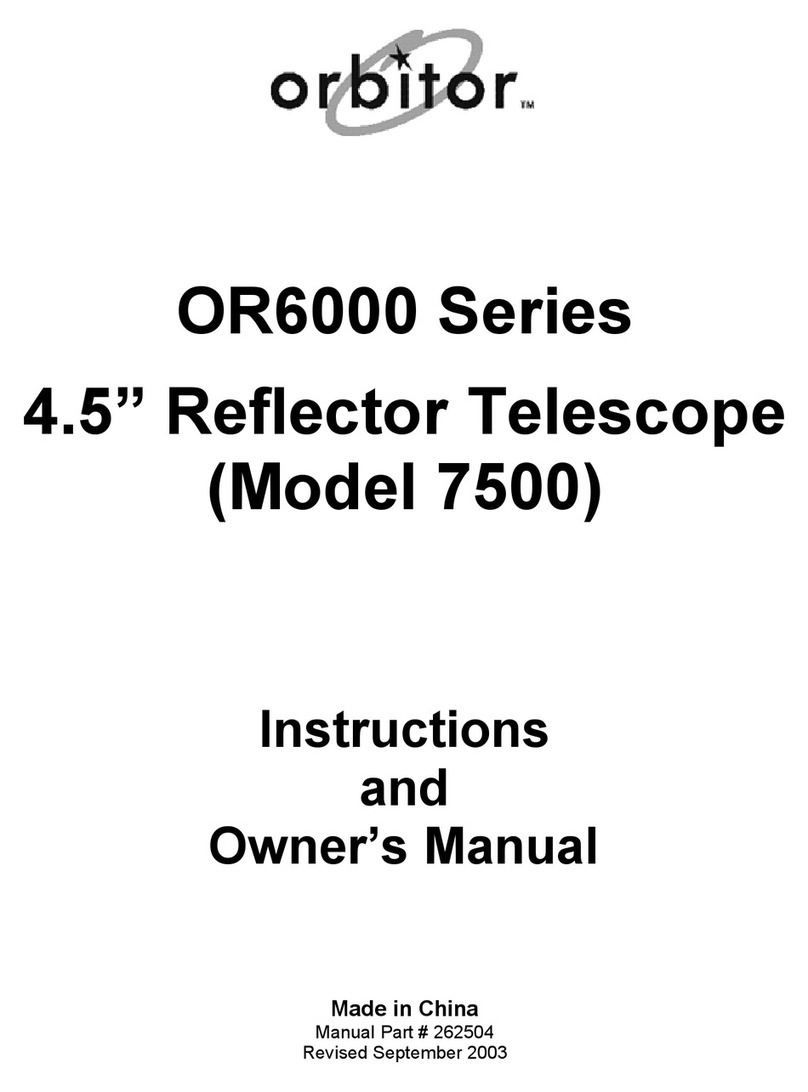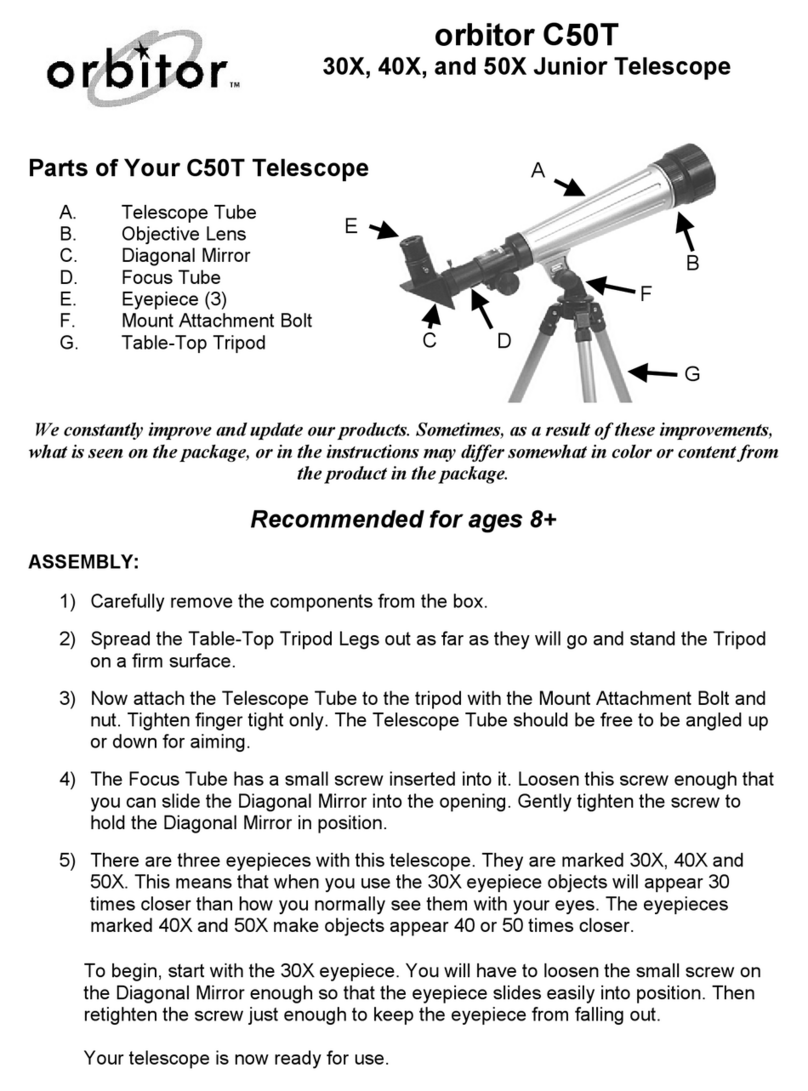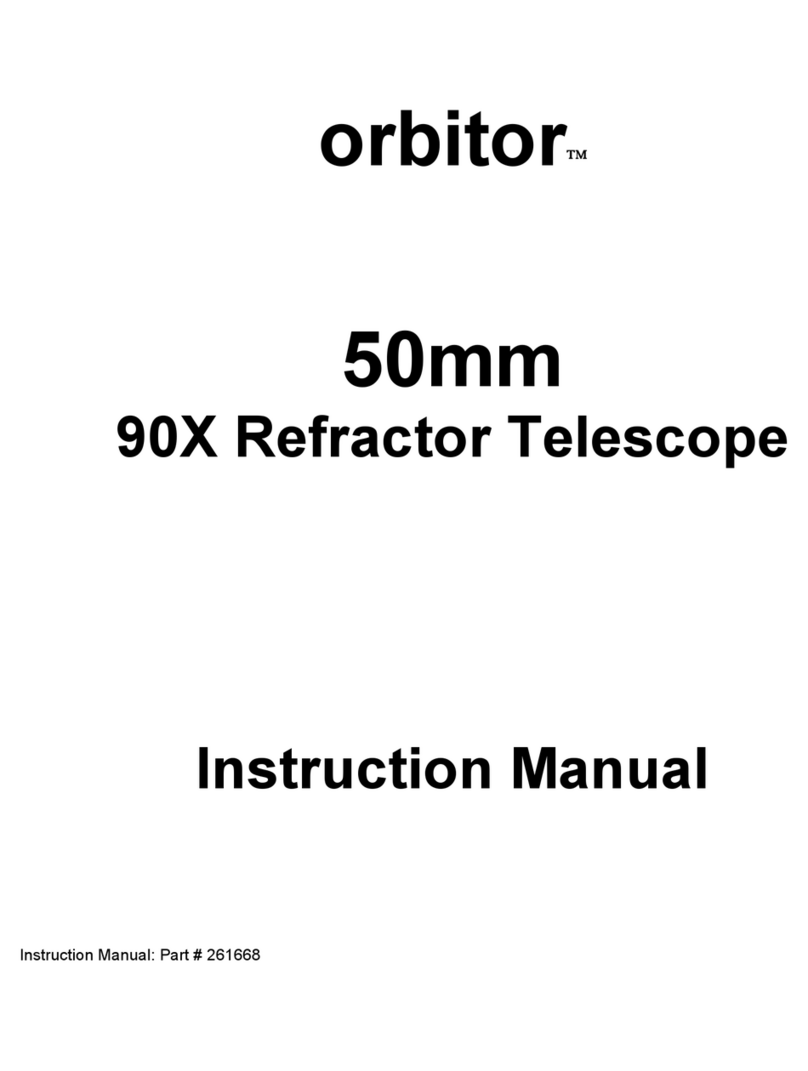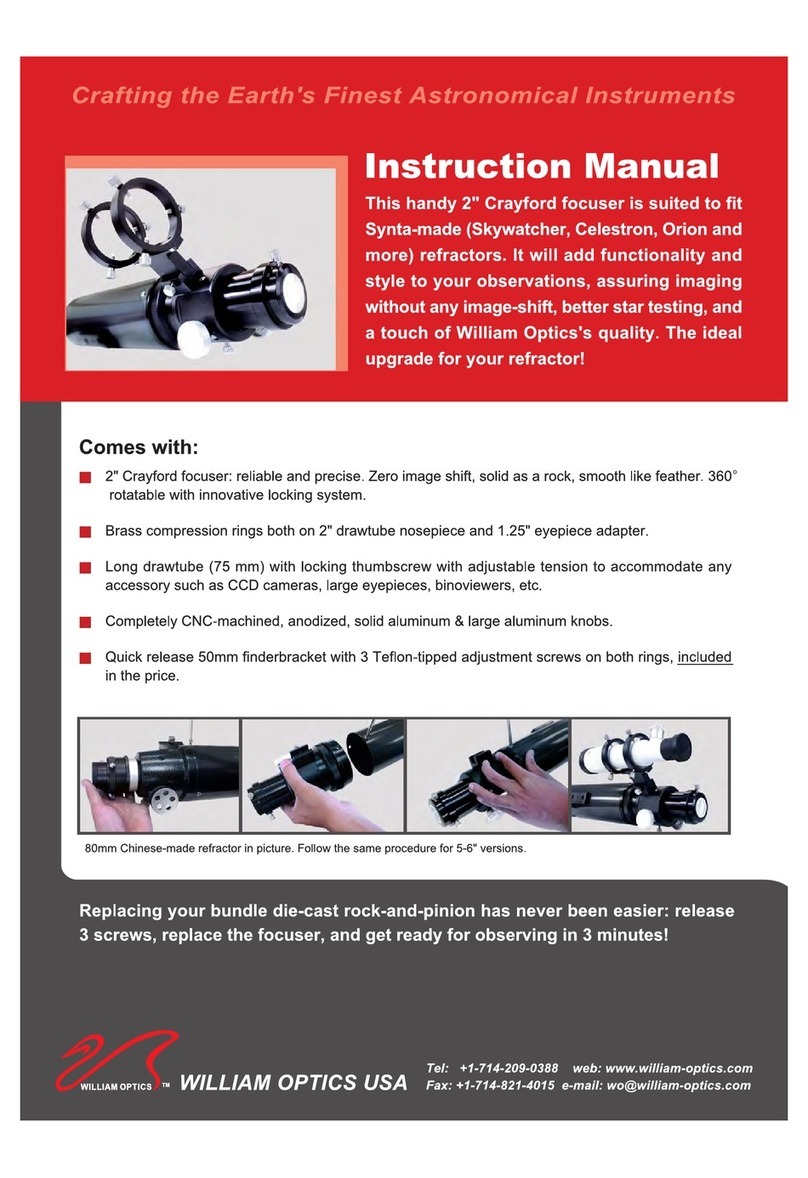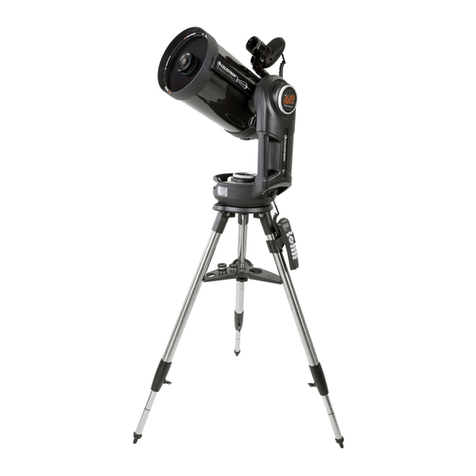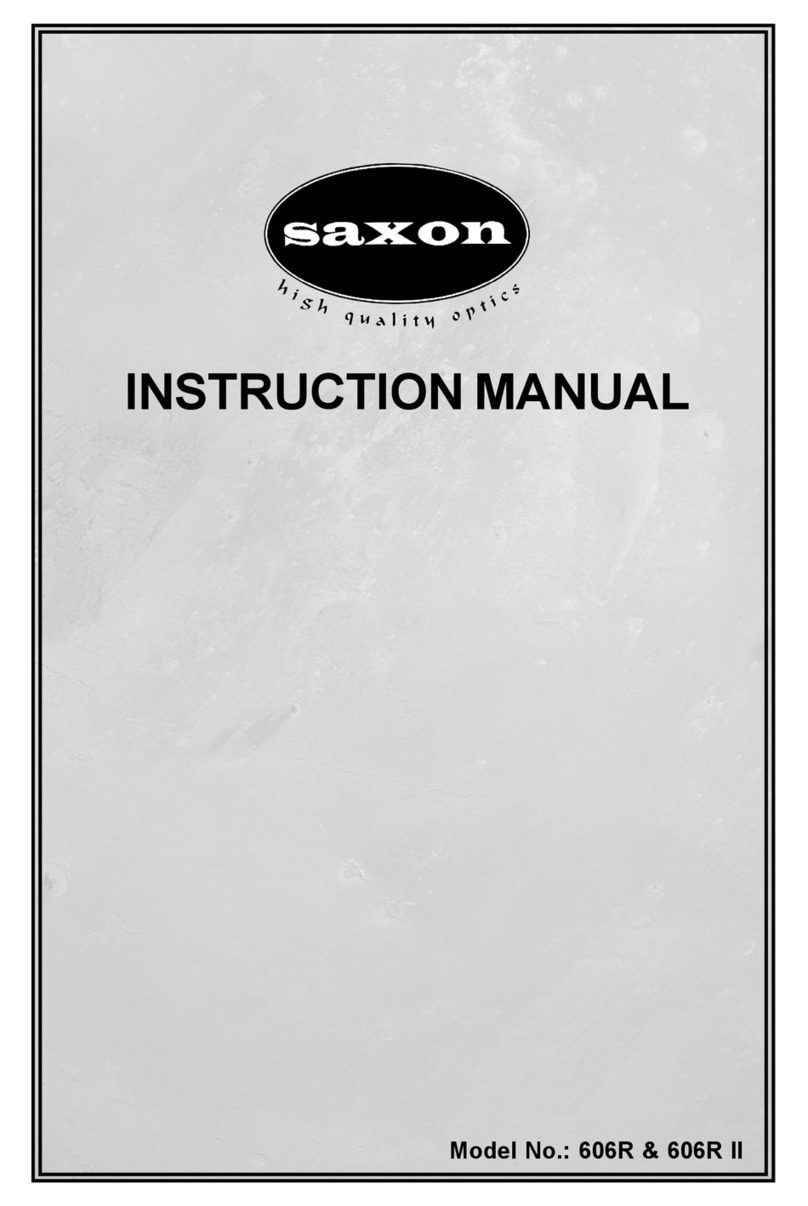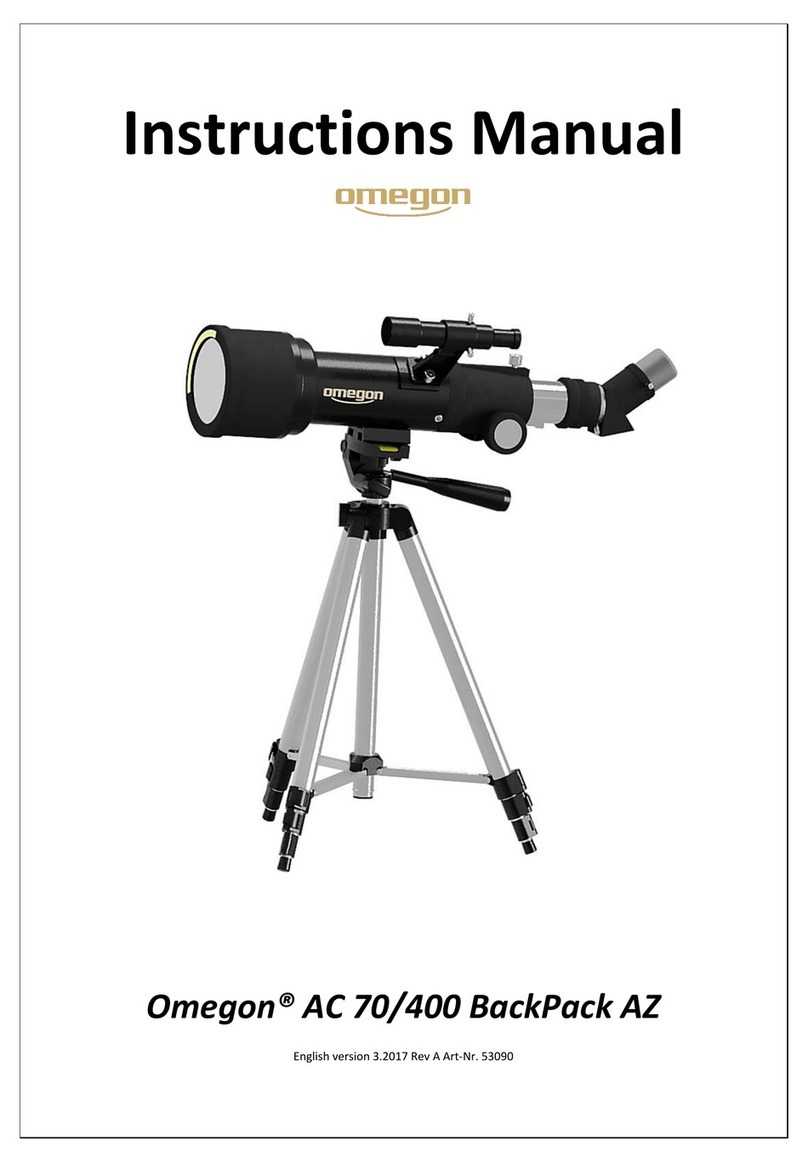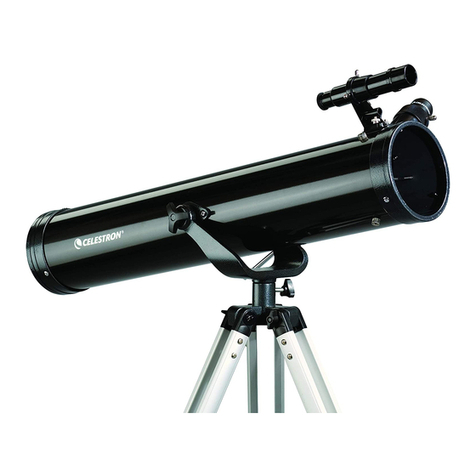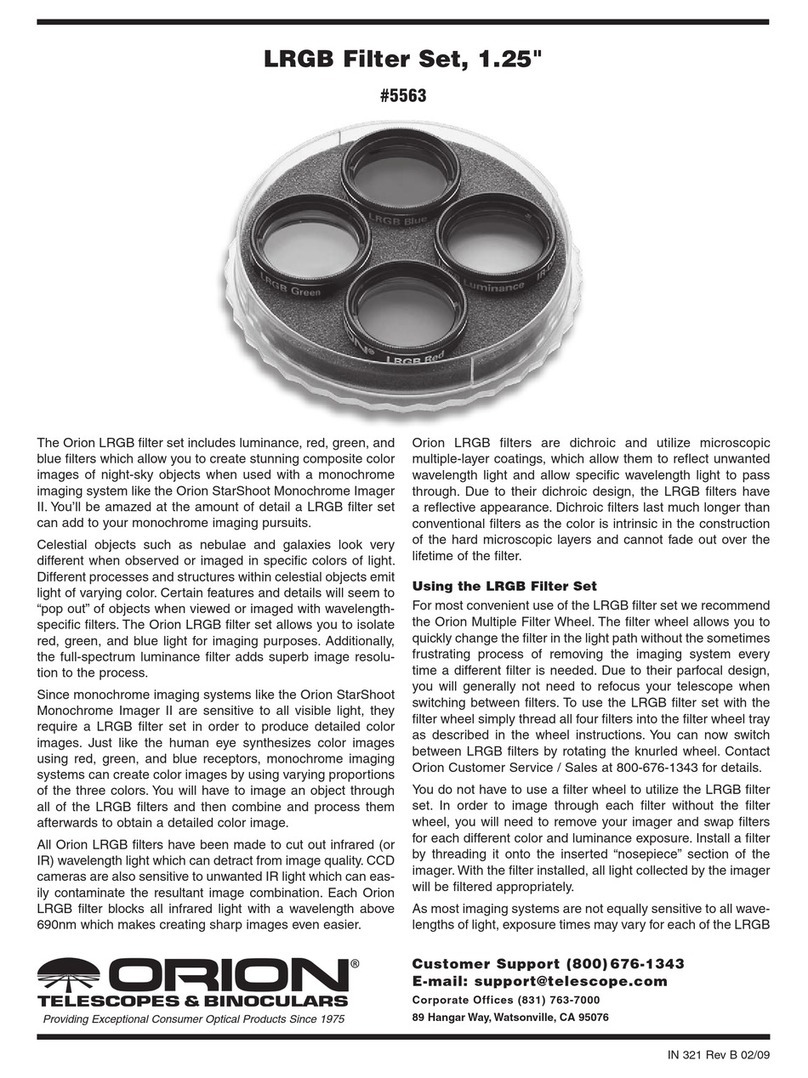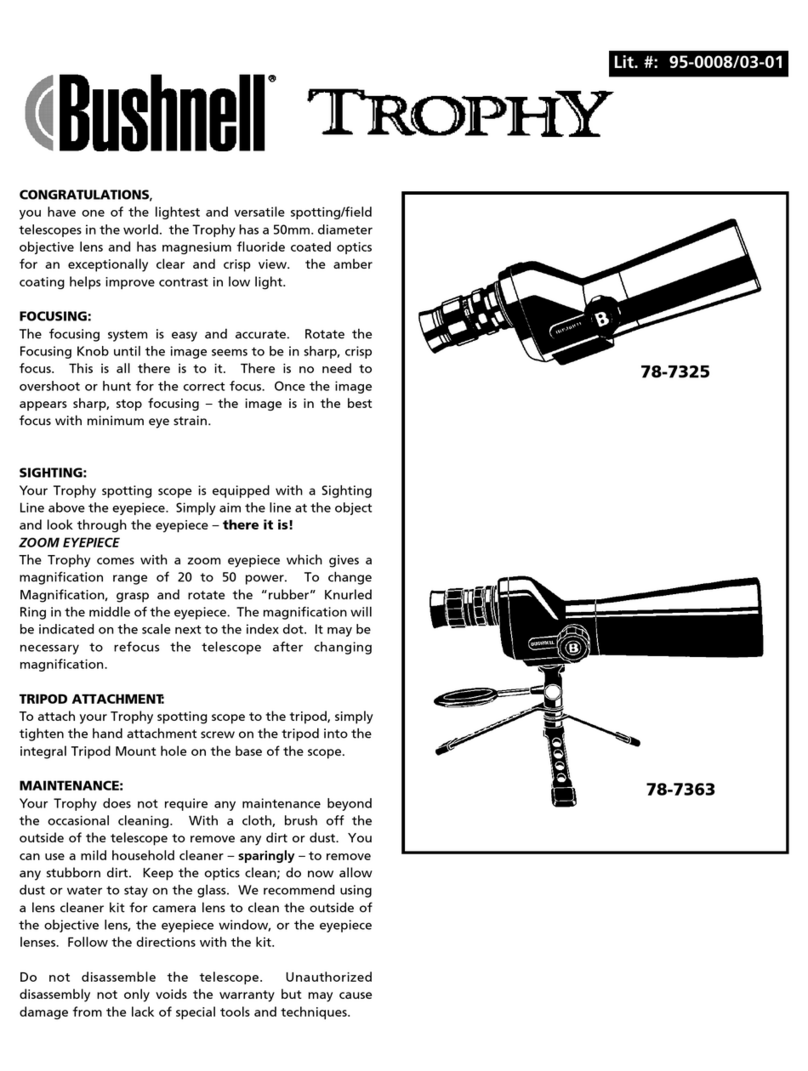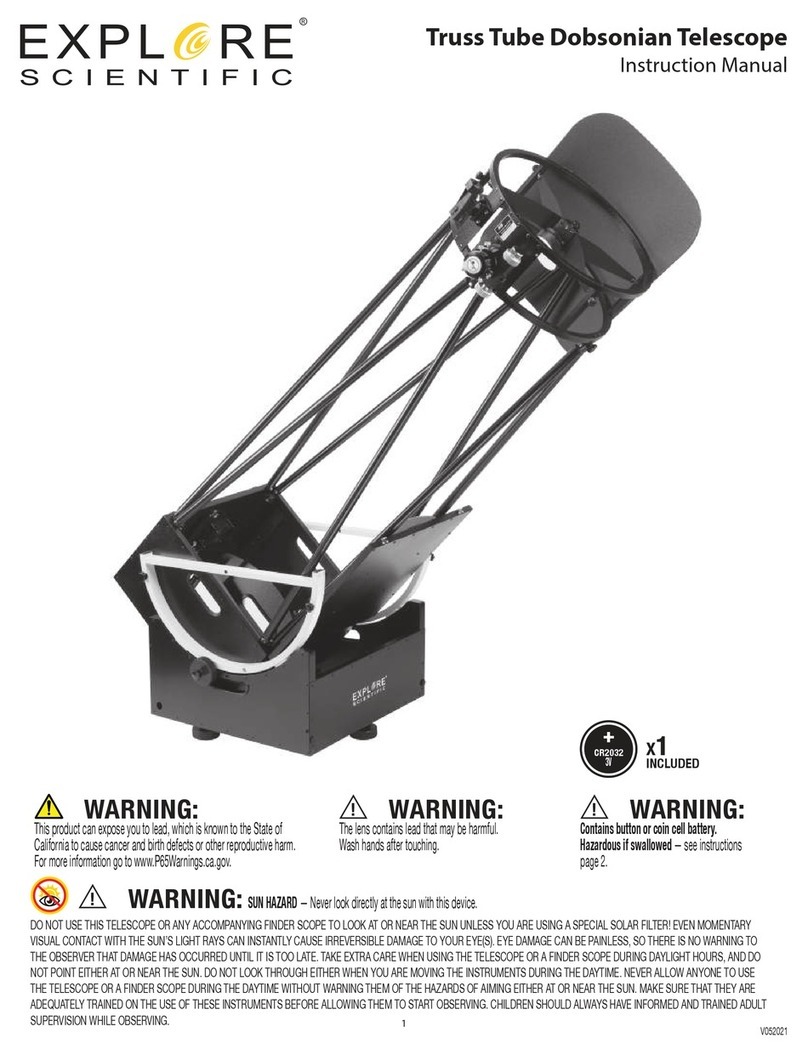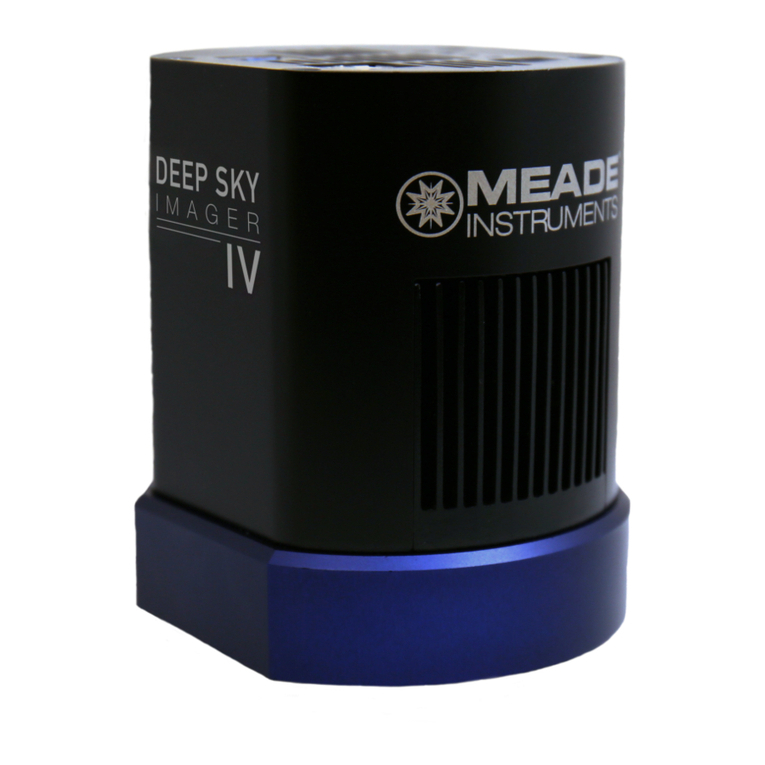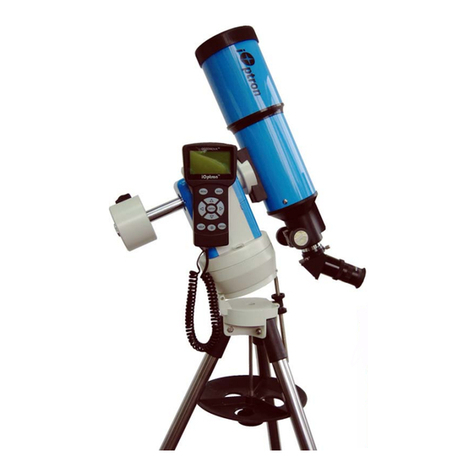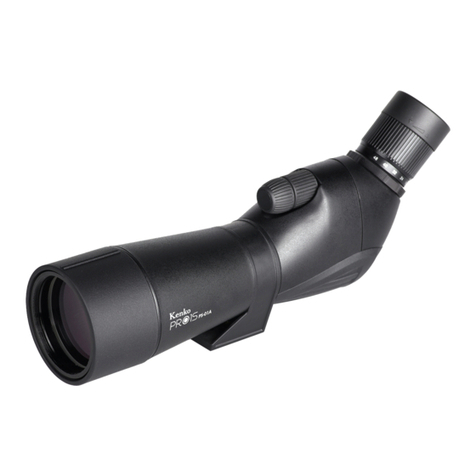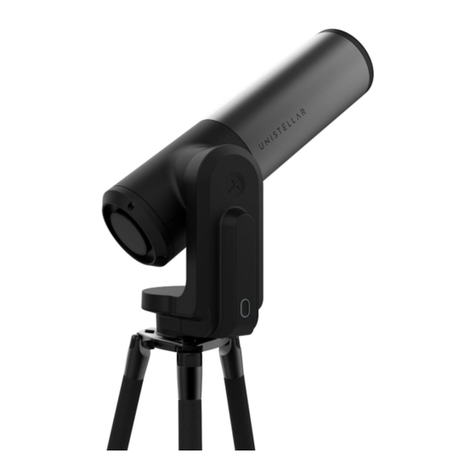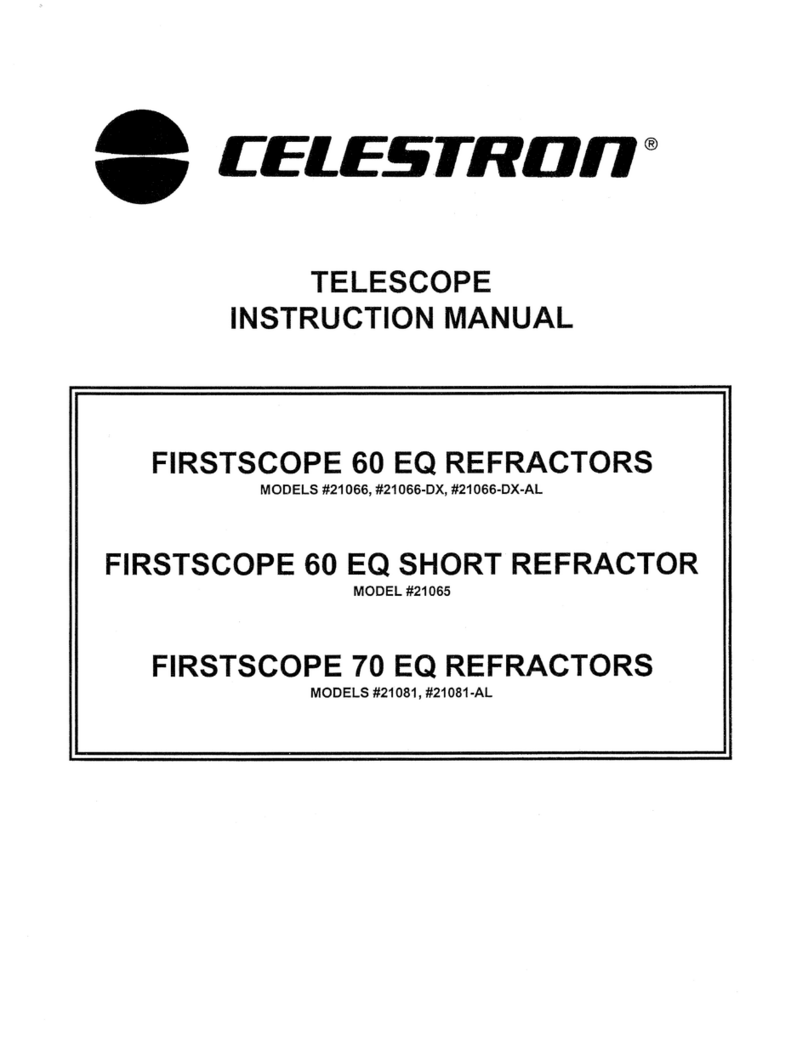Citiwell Orbitor C180T User manual

orbitorTM
Compact 180X
Telescope
Instructions
Manual Part # 260043

2
Component colors may differ from those shown in this manual.
WARNING!
NEVER aim your telescope at the sun or even close to the sun!
Instant and irreversible damage can occur,
including blindness!
Do not allow children under 12 to use any telescope without adult supervision.
Here are the main parts of your telescope:
A
: 20mm. Eyepiece
B: Focus Tube
C: Telescope Tube
D: Dew Shield
E: Diagonal Mirror
F: Focus Knob
G: Azimuth Lock Knob
H: Objective Lens (Not in view)
I: Altitude Lock Knob
J: Altazimuth Mount
K: Aluminum Tripod Leg
L: Dust Cap
M: 4mm. High Power Eyepiece
N: Tripod Supports
O: 2X Image Erector (May be
labelled 2X Image Erecting
Eyepiece)
D
H
J
I
K
N
A
B
C
E
F
G
L
M
O

3
Introduction:
Congratulations on your purchase of a precision-crafted orbitortelescope. With proper care and
handling of your telescope, you will enjoy the pleasure of looking at nature’s wondrous sights
through the eye of this instrument for many years.
This telescope has been designed to provide views of the moon’s craters, Jupiter’s major moons, and
Saturn’s rings, in addition to dozens of galaxies, star clusters, and nebulae. It also delivers great
views of mountains, valleys, and many other subjects, near and far, in the world around us.
You can also use your telescope as a terrestrial (land) telescope to study animals and landscapes at a
distance. To obtain the best performance from your telescope, please read this manual carefully and
completely.
ASSEMBLY:
1) Carefully remove all parts from the cardboard cartons and lay them on a table or floor in order
to take an inventory of all the pieces. Keep your box for storage or in case you ever need to ship
your telescope.
(Fig. 1)
2) Spread the three legs of the table-top tripod apart and gently press down on the center of the
tripod supports until they lock into place. (See Fig. 1)
!
WARNING!
CHOKING HAZARD
Small parts. Not suitable for
children under 3 years.

4
(Fig. 2) (Fig. 3)
3) Place the telescope tube over the altazimuth mount. Lower the telescope tube onto the mount
so that the plastic tongue on the mount slips into the bracket underneath the telescope tube. (See
Fig. 2)
4) One of the short bracket arms has a hexagonal shaped cutout around its opening. (See Fig. 3)
Insert the nut from the altitude lock knob into this cutout. Insert the altitude lock knob through
the bracket and tongue as shown. Turn the altitude lock knob clockwise into this nut until it stops.
5) Turn the tightening knob on the tripod mount clockwise until it stops. The telescope is now
securely attached to the tripod.
(Fig. 4)
6) Loosen the small chrome screw on the side of the focus tube by turning it counterclockwise.
Insert the shiny chrome end of the diagonal mirror into the focus tube so that the opposite open
end is facing upward. Tighten the small chrome screw on the side of the focus tube to hold the
diagonal mirror securely in position. (See Fig. 4)
7) Loosen the small chrome screw located on the side of the diagonal mirror by turning it
counterclockwise.
(Fig. 5)
8) Insert the low power eyepiece marked “H20mm” into the diagonal mirror. Tighten the small
chrome set screw by turning it clockwise to hold the eyepiece securely in place. (See Fig. 5)

5
THE ALTAZIMUTH MOUNT
This telescope is fitted with an Altazimuth mount. “Altitude" refers to the vertical movement of the
telescope, while "Azimuth" refers to the horizontal movement.
ABOUT MAGNIFICATION
The magnification power of a telescope indicates how much an image is enlarged or how big and
close it appears to the viewer. The focal length of the eyepiece, combined with the focal length of the
telescope, determine the magnification power. To calculate the power of your telescope with any
particular eyepiece, simply divide the focal length of the telescope (360mm) by the focal length of
the eyepiece (indicated in “mm” on the eyepiece collar).
Example: 360mm focal length (tube) = 18X magnification power
20mm focal length (eyepiece)
The two interchangeable eyepieces included, provide the following magnification powers:
Eyepiece Power
20mm 18X
4mm 90X
The level of magnification required depends on the object being observed.
A lower magnification power with a wider field of view is advisable for observing galaxies and
nebulae. Higher magnification powers should only be used for highly detailed observations of the
moon, Jupiter, and Saturn, or any object that is extremely bright
USING YOUR TELESCOPE FOR ASTRONOMICAL VIEWING:
1) Take your telescope outside. Viewing objects through closed or open windows is not
recommended. Your view can be distorted by reflections in the glass of a closed window or by air
currents, of differing temperatures, passing through an open window.
2) Let your telescope adjust to the outside temperature. Your telescope will perform much better if
the lenses and the air inside the tube are the same temperature as outside. It may take up to 30
minutes to equalize the temperatures when the difference in temperatures is extreme.
3) Find a location far from glaring light. If you live in an urban area, your viewing will probably
improve the farther you move away from the city lights. The skyglow of a town or city can
dramatically reduce the telescope’s performance and viewing capabilities.
When possible, avoid sudden temperature changes, as the moisture in the air will condense on the
objective lens. Should this occur after bringing your telescope inside, leave the lens cap off the

6
objective lens, tilt the objective (front) lens face down, and wait until the telescope reaches room
temperature.
With the diagonal mirror already attached and in place, we recommend starting your viewing with the
low power 20mm eyepiece because it gives you the widest angle with the brightest and sharpest
views. To adjust the angle of the telescope, loosen the azimuth lock knob by turning it
counterclockwise. Adjust the telescope to the desired angle, then tighten the azimuth lock knob.
NOTE: When using the diagonal mirror, objects will appear right-side up in your telescope, but
reversed, like a reflection in a mirror. This is normal, and does not indicate a defect.
USING YOUR TELESCOPE FOR TERRESTRIAL (LAND) VIEWING:
The brightest images will be seen when you use the 20mm eyepiece in conjunction with the diagonal
mirror. The mirror reversed image, however is confusing. This can be corrected with the included 2X
Image Erector. Te choice is yours.
To use the 2X Image Erector, remove the diagonal mirror. Insert the 2X Image Erector. Then insert
the 20mm eyepiece into the 2X Image Erector. The image seen will now be right side up and
correctly oriented.
As well as providing proper image orientation the 2X Image Erector also doubles the magnification
power of the eyepiece used. The effect is shown below. Remember that the brightness of the viewed
image decreases as the magnification power increases.
Eyepiece
Used Alone
Used with 2X
Image Erector
20mm 18X 36X
4mm 90X 180X
CARE AND CLEANING OF OPTICS:
Optical components of a telescope get dirty over time. Dirt or dust on a lens should be removed only
with the utmost care. A considerable amount of dirt or dust would have to accumulate on the optical
surface before your view would be compromised.
1.) Keeping any dust caps on during storage and transport will reduce dust collection.
2.) Condensation may collect on the optical surfaces when the telescope is not in use. Remove the
dust caps and allow the moisture to evaporate naturally. Point the telescope downwards to minimize
the accumulation of airborne dust.
3.) Once all moisture has evaporated, replace the dust caps.

7
4.) Filtered compressed air may be used to remove surface dust from lenses and mirrors. Remove
the dust cap and the dew shield. Once removed, point the can away from the lens and gently expel
some air and any condensation or dust that has accumulated on the discharge tube. Spray the lens
or mirror with short bursts of air to carefully remove the dust particles. DO NOT HOLD THE TRIGGER
OF THE COMPRESSED AIR CAN FOR EXTENDED PERIODS BECAUSE PROPELLANT FROM THE CAN
MIGHT ESCAPE AND DAMAGE THE OPTICAL SURFACE.
If, after several attempts, you cannot remove the particles, take the telescope to an optical
professional for cleaning.
If you keep the dust caps on your telescope when it is not in use and avoid handling the lenses or
mirrors, only minimal optical maintenance of your telescope should be required. Extensive cleaning is
usually only necessary every few years.
WHAT TO LOOK FOR IN THE SKY:
There is a whole universe of objects you could view at night, so where do you start? We recommend
starting with the most prominent objects first.
The moon
The moon is the easiest target to find at night. When the moon is in full position, it bathes the night
with a silvery light that washes the sky of all but the brightest objects. The best time to view the
moon is not when it is full, but rather when it is less than half full. The dividing line between dark and
light on the moon, called the terminator, shows the best detail in the craters and mountains.
The planets
The planets, our solar system companions, range in size from moon-size rocky bodies to giant gas
balls, which could hold Earth 1000 times over. To find the planets, you will need information about
their times of visibility. An astronomy magazine will give you the locations of the planets, as they
change position from month to month. The Internet is also an excellent source of information,
starcharts, maps, and more! The popular and more familiar constellations often provide the easiest
landmarks to help find the planet’s locations and paths of orbit. Most people have looked up at night
and seen some of the planets without even realizing it. A planet appears like a bright star but does
not twinkle like a star; it will look like a tiny ball. Venus, Mars, Jupiter, and Saturn, are the easiest
planets to view. Mercury is dimmer, usually below the horizon, and is more challenging to find.
Each of the planets provides interesting views. Venus is covered with clouds so all that is visible is an
extremely bright light, the brightest next to the moon. Venus, like the moon, goes through phases,
however. As it travels around the sun, different areas of the planet’s surface are illuminated,
producing crescent shapes of varying size. Mars is the red planet. When it is above the horizon, it is
noticeably red and stands out like a beacon in the night sky. The apparent brightness of Mars varies
as the planet orbits around the sun and throughout its period of visiblity, it will brighten and dim
depending on how near or far it is from Earth.

8
Jupiter is the largest planet in our solar system and the second brightest next to Venus. Jupiter has
many moons, four of which are often visible through your telescope, when viewing conditions permit.
As you watch them throughout the evening, you will see that they change position relative to each
other and to Jupiter. It is possible with careful planning to actually see one of the moons disappear
either in front of or behind Jupiter as it orbits around the planet.
Saturn, the second largest planet, is not as bright as Jupiter and so its moons are not as visible
through small telescopes. The large rings that encircle Saturn are spectacular to observe, however.
The planet and its rings appear pale yellow.
FREQUENTLY ASKED QUESTIONS:
1) How far can I see?
If you stand outside and look up at the night sky on a clear evening, you can see hundreds of stars
with the unaided eye. The telescope is a light-gathering instrument which magnifies the view—
providing significantly more detail and unveiling more stars, nebulae, and celestial objects. With the
aid of a telescope, you will be able to enjoy exciting views of Saturn’s rings, Jupiter’s major moons,
the Orion Nebula, and much more.
2) Why can’t I see anything?
If you see only gray or black when looking through your telescope, even after searching for an object
to view, it is very likely that you are using an eyepiece that is too powerful. To solve this problem:
Always start with the lowest power eyepiece first, and only insert the higher power eyepiece after
you have located an object.
3) When I use my high power eyepiece, everything looks much darker. Why?
As magnification in a telescope increases, brightness diminishes. Conversely, brightness increases
when magnification is reduced. If an image appears too dark or unclear, use a lower-powered
eyepiece. Views of small, bright objects are superior to those of large, dark or blurry ones!
Atmospheric conditions, air currents, as well as light and air pollution also affect viewing quality.
4) As I look through my telescope, objects in the sky appear to move. Why is that?
The constant rotation of the earth makes things appear to move. Lower-power eyepieces will reduce
this effect of movement considerably and allow you to observe an object for a longer duration before
you have to readjust your telescope.
Made in China
Manual Part # 260043
Table of contents
Other Citiwell Telescope manuals
